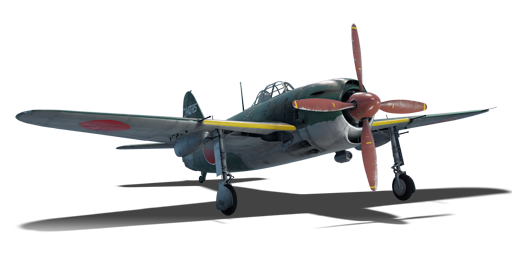



The N1K1-Ja, designated as Shiden Mod.11 Ko (紫電一一型甲), was the result of Kawanishi's adaptation of the canceled N1K1 floatplane project into a land-based fighter by replacing the floats with conventional landing gear. To improve the performance of the Shiden, Kawanishi swapped the original Mitsubishi Kasei 13 engine with the more powerful Nakajima Homare series, initially using the Homare 11 and later choosing the Homare 21 for mass production. The Shiden was a formidable opponent for Allied fighters over the Pacific and was the first land-based fighter designed by Kawanishi, a company specializing in floatplanes. The Shiden was quickly deployed and became the most feared Japanese fighter of the war.
It was introduced in Update 1.59 "Flaming Arrows". The N1K fighter series are famed and feared land-based fighters, and this is the first one in the line. It has great manoeuvrability at medium speeds and powerful weapons. It can out-turn most foes except some Japanese and British planes, but it lacks speed and climb performance. It is not good for diving and zooming attacks. It can fight well at 350-450 km/h and take down bombers with its powerful armament. It should steer clear of faster and more nimble enemies, or make them turn fight at higher speeds.
flaps
flaps
flaps
brake
| Belt | Belt filling | Armor penetration (mm) at a distance: | |||||
|---|---|---|---|---|---|---|---|
| 10 m | 100 m | 500 m | 1000 m | 1500 m | 2000 m | ||
| T/FI/FI/APHE | 26 | 24 | 17 | 10 | 6 | 4 | |
| HEF-T/HEF/HEF/APHE | 26 | 24 | 17 | 10 | 6 | 4 | |
| APHE/APHE/APHE/APHE/HEF/HEF-T | 26 | 24 | 17 | 10 | 6 | 4 | |
| HEF-T | 4 | 4 | 3 | 3 | 3 | 3 | |
| HEF/HEF/HEF/APHE/APHE | 26 | 24 | 17 | 10 | 6 | 4 | |
| Belt | Belt filling | Armor penetration (mm) at a distance: | |||||
|---|---|---|---|---|---|---|---|
| 10 m | 100 m | 500 m | 1000 m | 1500 m | 2000 m | ||
| T/AP/IAI/AP/I | 13 | 12 | 7 | 3 | 2 | 0 | |
| T/AP/IAI/AP | 13 | 12 | 7 | 3 | 2 | 0 | |
| T/T/T/AP | 13 | 12 | 7 | 3 | 2 | 0 | |
| I/AP/AP/AP/IAI | 13 | 12 | 7 | 3 | 2 | 0 | |












Flight performance | |
|---|---|
Survivability |
|---|
Weaponry | |
|---|---|